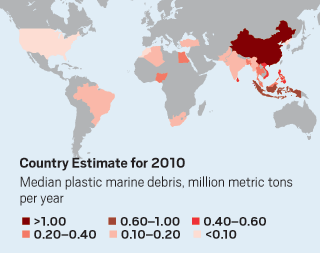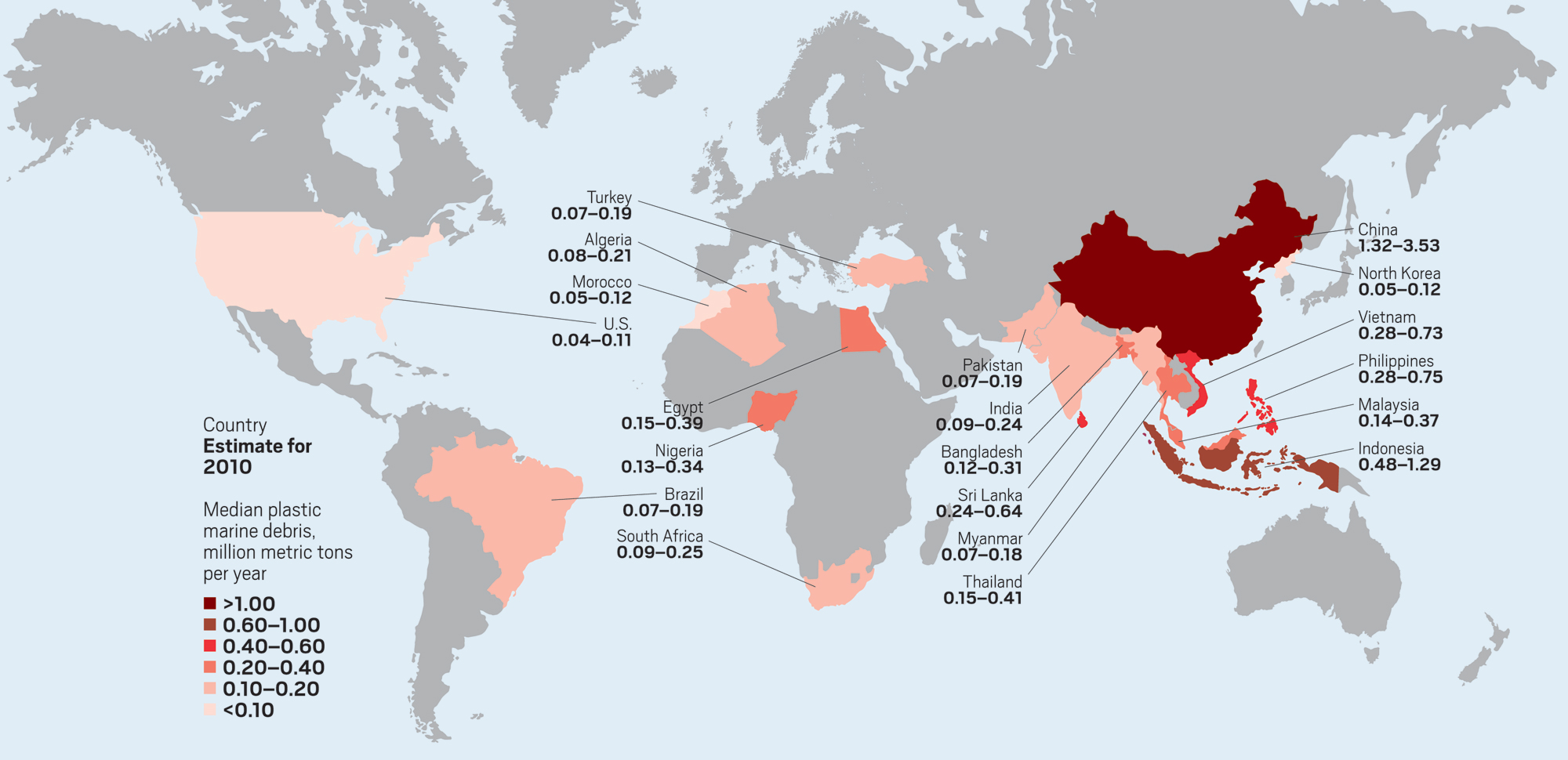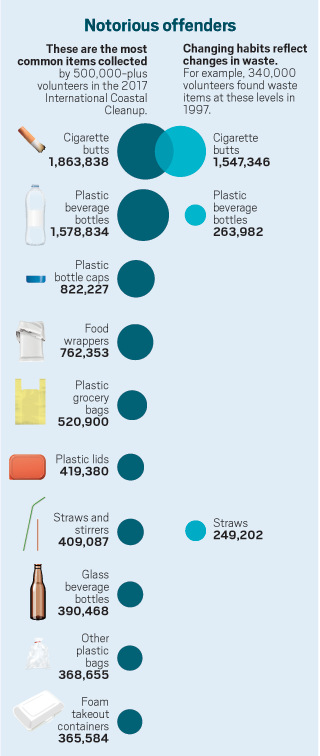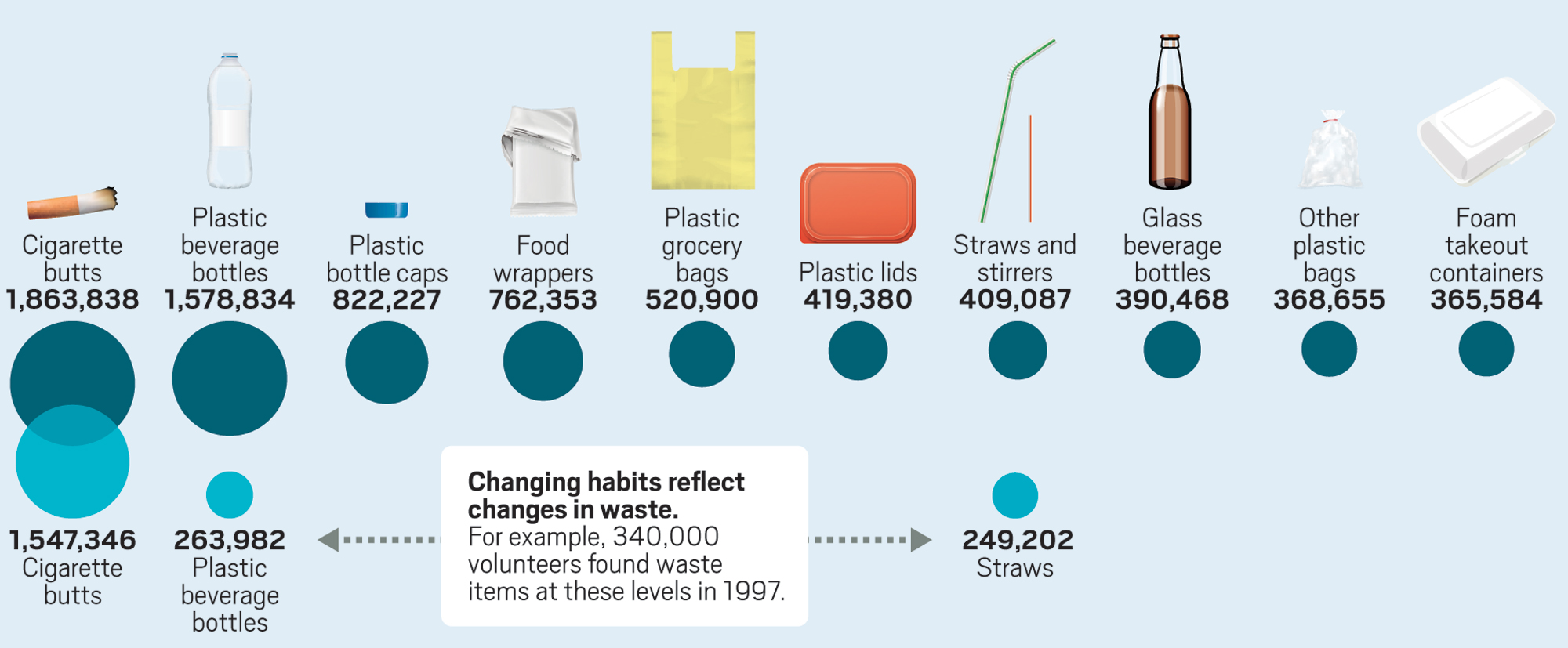Advertisement
Grab your lab coat. Let's get started
Welcome!
Welcome!
Create an account below to get 6 C&EN articles per month, receive newsletters and more - all free.
It seems this is your first time logging in online. Please enter the following information to continue.
As an ACS member you automatically get access to this site. All we need is few more details to create your reading experience.
Not you? Sign in with a different account.
Not you? Sign in with a different account.
ERROR 1
ERROR 1
ERROR 2
ERROR 2
ERROR 2
ERROR 2
ERROR 2
Password and Confirm password must match.
If you have an ACS member number, please enter it here so we can link this account to your membership. (optional)
ERROR 2
ACS values your privacy. By submitting your information, you are gaining access to C&EN and subscribing to our weekly newsletter. We use the information you provide to make your reading experience better, and we will never sell your data to third party members.
Polymers
Fighting ocean plastics at the source
Governments, nongovernmental organizations, and industry are turning their attention to developing countries in Asia to stop the flow of plastics into the sea
by Alexander H. Tullo
April 16, 2018
| A version of this story appeared in
Volume 96, Issue 16

Credit:
In Muncar, on the coast of East Java, Indonesia, fishers still make their living the traditional way, launching from the shore in the hand-painted boats they have used for generations.
But that doesn’t mean that this harbor town is untouched by time. Plastic waste is mounting on the riverbanks and in the waters around Muncar. Some probably lurks within the fish brought ashore on the boats.
Muncar is the second-largest fishing port in Indonesia, but it has barely a semblance of a waste management infrastructure. Dorothea Wiplinger, the sustainability manager for Austrian plastics maker Borealis, was on the ground in Muncar recently studying the problem. She says nearly 90% the garbage, mostly organic waste, that local inhabitants generate is either dumped haphazardly or burned.
In brief
Some 8 million metric tons of plastic escapes into the world’s oceans each year,most of it from countries in Southeast Asia, where plastics use has outpaced waste management infrastructure. The situation is approaching catastrophic proportions. Read on to learn how governments, companies, and other organizations are focusing on the region in the hope that stopping the flow of trash there will substantially decrease plastic pollution.
“You cannot see the sand anymore because the beaches are just full of waste. And then the high tide takes the waste away,” she says. “The people there don’t have any other choice.”
The developing world is dotted with places like Muncar. The problem is particularly acute in China and in the Southeast Asian countries of Indonesia, the Philippines, Thailand, and Vietnam. These five countries alone are responsible for most of the plastics that end up in the ocean.
In such countries, rising affluence is allowing people to buy more plastic-wrapped food and drink than they could before. But infrastructure hasn’t kept up, leaving citizens with no environmentally sound means to throw stuff away.
By developing better waste management practices, like those that already exist in wealthier places, these countries could stop the trash from escaping into the ocean.
But some observers have more drastic measures in mind. A recent editorial in the Los Angeles Times declared that the “sheer volume of plastic trash now littering Earth has become impossible to ignore.” Piecemeal bans by states and cities on plastic bags and drinking straws can’t clean up the environment fast enough, the paper said. It called for phasing out all single-use plastic.
Governments in places like Indonesia and Sri Lanka have pledged to improve. The plastics industry, eager to see the problem disappear, is mobilizing with business-friendly nongovernmental organizations (NGOs) to develop methods for collecting, sorting, and recycling plastic trash. The parties hope they can roll out the solutions fast enough and at a large enough scale to make a difference to the ocean.

Source: Science, 2015, DOI: 10.1126/science.1260352

Source: Science, 2015, DOI: 10.1126/science.1260352

Source: Science, 2015, DOI: 10.1126/science.1260352
A growing problem
Scientists have been sounding the alarm about ocean plastics for more than a decade. And in recent years, the facts have grown increasingly disconcerting.
One of the earliest warnings came from the International Coastal Cleanup, run by Ocean Conservancy, an NGO. The International Coastal Cleanup began in 1986 when 2,800 volunteers collected 110 metric tons of debris on the Texas coast. Last year, a half-million volunteers from all around the world collected more than 8,300 metric tons of garbage.
The volunteers keep meticulous data, which amounts to a vast waste characterization survey of the world’s coastline. Last year, nine of the top 10 items collected were plastics, including beverage bottles and caps, food wrappers, straws, and grocery bags.
“It is really meant to be a snapshot of the most persistent items that are littering our beaches and waterways,” says Nick Mallos, director of the Trash Free Seas Program at Ocean Conservancy. “Over time, we have seen a shift towards more and more plastics, which reflects the global marketplace and the shift to plastics as the dominant material.”
Scientists have also been probing the ocean itself to understand the plastics problem. Organizations such as Algalita Marine Research & Education and the 5 Gyres Institute have been sending expeditions to trawl the oceans to capture plastics and assess how widespread the problem has become. Over the past decade, they succeeded in bringing the public’s attention to the North Pacific Subtropical Gyre, nicknamed the Great Pacific Garbage Patch, an area where currents converge and plastics flotsam accumulates.
In 2014, these organizations pooled data from their expeditions to estimate that 5 trillion pieces of plastic trash, weighing more than 250,000 metric tons, were afloat at sea.
Britta Denise Hardesty, a principal research scientist with Australia’s Commonwealth Scientific & Industrial Research Organisation, has seen plenty of ocean plastics firsthand. Her fieldwork on plastics ingestion by birds has taken her to remote areas of Tasmania and Western Australia reachable only by pontoon plane. “You don’t see a single coastal site where you don’t find trash,” she says.
“It is reasonable to think that if we continue in the direction where we are going now, there’s going to be ecosystem impact,” Hardesty says. “Plastics don’t belong in our stomachs, in our food chain, or over our reefs. That stuff smothers and kills things.”
Hardesty recently participated in a study that dissected 378 seabirds in eastern Australia. Some 24% of them had debris in their digestive tracts. She helped compile a survey of published data suggesting that, by 2050, 95% of all seabirds will be ingesting plastic if the pollution isn’t mitigated.
Chelsea Rochman, assistant professor in the department of ecology and evolutionary biology at the University of Toronto, sees similarly alarming trends in fish. She led a 2015 study in which researchers bought fish at markets in Indonesia and California and dissected them to see if they could find microplastics—less-than-5-mm fragments that result when the environment shreds littered plastics over time. She found microplastics in 28% of the 76 fish from Indonesia. She also found debris in 25% of the 64 fish procured in California. In the U.S., most of the waste was microfiber, possibly from laundry water.
“That did get a lot of attention, I think because it is kind of striking to say that there’s plastic in your seafood,” Rochman says. “And it shows that the mismanagement of our waste has come back to haunt us on our own dinner plates.”

Researchers are probing other fundamental questions, Rochman says, such as how plastics might affect fish health. They have found plastic particles in fish blood cells, livers, and even brains. Plastics probably leach chemicals into fish and, she says, have been shown to promote liver tumors and pathology in their gonads.
In 2015, it became clear that the scale of the ocean problem was even bigger than was uncovered in the earlier gyre studies. That’s when a team led by Jenna Jambeck, an assistant professor of environmental engineering at the University of Georgia, published a paper titled “Plastic Waste inputs from Land Into the Ocean” in Science (2015, DOI: 10.1126/science.1260352).
Jambeck had read about the gyre expeditions and wondered if she could estimate the rate at which plastics were entering the world’s oceans from data about human consumption. “I thought that if our waste is ending up in the ocean, then it is probably because of something that is happening on land,” she recalls.
The team made assumptions about waste generation and probable plastics use in coastal populations around the world. Using the World Bank’s country-level data on waste management practices, they estimated how much waste was mismanaged through improper collection and disposal. Finally, the team modeled how much of that mismanaged waste hemorrhaged into the ocean. The conclusion: between 4.8 million and 12.7 million metric tons during the basis year of 2010.
Based on the study’s mid-range estimate of 8.0 million metric tons, leakage amounted to 3% of the world’s 2010 plastics production of 265 million metric tons, as reported by the trade group PlasticsEurope.
The Jambeck paper suggests that plastics waste could reach crisis proportions if people don’t come up with remedies more quickly than consumption increases. Plastics leakage to the ocean might grow to 17.5 million metric tons per year by 2025, and the cumulative buildup could hit 155 million metric tons by that time, doubling today’s levels.
Jeff Wooster, global sustainability leader for Dow Chemical’s packaging business, credits the Jambeck publication with creating a heightened sense of urgency. “I think a lot of people didn’t really recognize how big the magnitude of the problem was and how serious the crisis could be if it is not fixed,” he says.
A plan for plastics
Ocean Conservancy’s Mallos says the influence of the Jambeck paper cannot be overstated. “It really was a hallmark moment in this dialogue, and it really changed the global discourse from one that was largely focused on gyres to one recognizing a large vector from land, where we can intervene,” he says.
Advertisement
A key to this intervention is Jambeck’s observation that certain countries contribute more to ocean waste than others. According to her team’s survey, five countries—China, Indonesia, the Philippines, Sri Lanka, and Vietnam—contribute more than half of ocean plastics. Improve waste infrastructure in these places, and significantly less plastic will escape into the ocean overall.
But the paper hardly exonerates countries with developed waste infrastructure. Because of littering of about 2% of total waste and very high per-capita consumption of plastics, the U.S. ranks 20th in the world.
Ocean Conservancy built on Jambeck’s paper and added its own analysis as well as research on the ground in China and the Philippines to come up with a blueprint for reducing plastic waste in the ocean. Its widely referenced report, “Stemming the Tide: Land-Based Strategies for a Plastic-Free Ocean,” came out later in 2015.
The Ocean Conservancy report focused largely on ocean leakage from the top five countries. Using its own research, it substituted Thailand for Sri Lanka as the fifth country. The group maintains that these five countries could reduce plastics litter to the ocean by 65% as early as 2025, reducing overall marine plastics leakage by 45%. The effort would cost $5 billion annually.
The essence of the plan is that towns and cities need to collect more garbage from residents. Ocean Conservancy estimates that 75% of plastics leakage comes from uncollected waste. Collection is sometimes as low as 10% in rural areas of China and the Philippines.
The other 25% of the leakage comes from cracks in the waste management system itself, the NGO says. This happens, for example, when an open-air dump is located near a river, allowing plastics to blow into the water. Remedies include better landfills, recycling, and waste-to-energy facilities where combustion can take plastics out of circulation for good.
The report says the region needs political commitment to see the reforms through. It calls on governments, NGOs, and the private sector to establish proofs of concept for local waste management schemes.
Mallos says governments have strong incentives to act. Collecting trash, after all, helps public health, too. “When it comes to waste management, it is not just good for the ocean,” he says. “It is good for society.”

Source: International Coastal Cleanup

Source: International Coastal Cleanup

Source: International Coastal Cleanup
Acting for oceans
Whether it is because they themselves have recognized the need to improve or they are reacting to prodding from NGOs, governments in Asia are starting to act. For example, noting that “marine plastic debris is a slow-motion catastrophe,” Indonesia made a commitment to the United Nations last year to reduce plastics debris by 70% by the end of 2025. The government said it would spend $1 billion to improve waste management and that it is eager to work with the private sector.
Sri Lanka banned single-use plastic items like shopping bags last year after a garbage dump collapse killed 32 people. Officials hope the ban will rein in the country’s reputation as one of the worst offenders when it comes to ocean plastics.
Some people think China’s new ban on the importation of postconsumer plastics may have a beneficial impact on the ocean. The country had been importing millions of metric tons annually from the U.S. and Europe for recycling. But a straw thrown into a recycling bin in Sacramento could easily end up adrift in the China Sea.
“They were importing mixed plastics, and they were picking through it and taking out the most valuable items, and the rest were just discarded into the environment,” Dow’s Wooster says.
The big fear about the China ban, however, is that the U.S. and Europe will simply export their waste plastics to other Asian countries rather than process them at home.
Increasingly, the plastics industry is heeding the call from NGOs and governments to collaborate. Companies are betting that focusing on Asia could yield dramatic results and remove a black eye on the industry.
Last year, Borealis, along with its joint-venture company Borouge and its recycling affiliate Mtm Plastics, kicked off a $5 million program with Indonesian officials and the social entrepreneurial firm SystemIQ. The partners are attempting to eliminate ocean plastics in Muncar by establishing a waste collection system and diverting plastics toward recycling.
“We want to create a mini-circular economy in that specific location—a proof point that a circular economic system works for that city—and then scale up,” Borealis’s Wiplinger says.
So far, the partnership has collected data on waste characterization and leakage. It has also assessed the informal plastics recycling sector—the trash pickers who pluck out metals and high-value plastics like polyester and polyethylene containers for recycling. “The plastic items that are wasted are mostly low-value flexible packaging items,” Wiplinger observes.
This month, the partners will implement the project using data they’ve collected. Their plan includes establishing sufficient collection points, deploying waste collection trucks and processing facilities, and hiring additional staff.
The partners also want to stimulate a market for difficult-to-recycle plastics like flexible packaging. “You have to increase recycling because this will give you the revenue that you need to finance waste collection,” Wiplinger says.
Dow has a long history with the marine plastics issue. It has been sponsoring the coastal cleanup since the first Texas event more than 30 years ago. As plastics consumption and litter grew, Wooster says, the company realized that it was “not going to fix this littering problem just by doing beach cleanups.”
About seven years ago, Dow helped form the Trash Free Seas Alliance with Ocean Conservancy and other big corporate sponsors like Coca-Cola. More recently, the company pledged $2.8 million toward efforts to fight marine debris.
For example, Dow is sponsoring a program to build roads in Indonesia and India made in part with flexible packaging that is otherwise difficult to recycle. Engineers recently blended 3.5 metric tons of plastics into a 1.8-km road laid in West Java, Indonesia. Such roads sequester plastic that might otherwise be discarded and may last twice as long as a conventional road.
Companies like Dow are feeling public pressure over the environmental impact of their products. And they aren’t being hounded just by one viral LA Times editorial. Some NGOs have made reducing and eliminating single-use plastics part of their advocacy platforms.
For example, one of the groups that sponsors the ocean plastics expeditions, 5 Gyres, along with other environmental groups, publishes the BAN (Better Alternatives Now) List, which includes many of the products that are ubiquitous in ocean cleanups. On it are bags and straws but also products such as food wrappers and beverage bottles, which the plastics industry has long insisted offer the environmental benefit of preserving food.
“I don’t think that the attention on fixing the problem in Southeast Asia is necessarily directed at preventing bans on single-use plastics,” Dow’s Wooster says. But he does admit that it’s bad for business when people turn against plastics because of a perceived impact on the environment.
“If they view it that way and it causes them not to use that material, then we know we don’t have a market anymore,” he says.
It isn’t just companies that make plastics that are trying to get involved. Last year, Procter & Gamble, the world’s largest consumer products company, transformed the plastics that volunteers collected on French beaches into 150,000 Head & Shoulders shampoo bottles. This year, the company is rolling out Fairy dish detergent bottles made of ocean plastics.
Steve Sikra, associate director for global product stewardship at P&G, says the effort is meant to raise awareness in the minds of consumers “to signify plastic has value.” Additionally, he says the products are meant to highlight to consumers P&G’s goal of using 25% recycled content in its products in Europe by the end of this year.
P&G, along with Ocean Conservancy, the American Chemistry Council, Pepsi, Dow, and 3M, is participating in Closed Loop Ocean, an initiative pledging $150 million toward stopping plastics leakage in Southeast Asia.
Closed Loop Partners will manage the program. In the U.S., Sikra explains, its Closed Loop Fund, where he serves as an advisory board member, provides low-interest loans for recycling projects. These loans bear most of the financial risk and thus encourage commercial lenders to step up and provide the balance of the financing.

Closed Loop has helped fund recycling trucks in Ohio, material recovery facilities in Florida and Nebraska, and an enhanced recycling program in Connecticut. With the ocean plastics program, Closed Loop hopes to duplicate the same model in Southeast Asia, Sikra says. “It is about galvanizing investment in waste and recycling solutions in that part of the world.”
But Dow’s Wooster stresses that more than pilot programs are needed to make a dent in the problem. “We have taken these small projects, and we have learned from them,” he says. “The challenge for the industry right now is how do we start thinking bigger picture and on scalable solutions.”
That’s precisely Dell’s goal with its ocean plastics initiative. Last year, the computer company used about 7 metric tons of plastics that had been dumped in Port-au-Prince, Haiti, to create packaging for its XPS 13 laptop. The company aims to increase usage 10-fold by 2025.
To boost its numbers, Dell is establishing a supply chain for plastics that have been improperly disposed of and are likely headed for the ocean. The company used data that it gathered in Port-au-Prince, such as population density and proximity to water, to come up with models to predict where trash accumulates. It then compared that data with satellite imagery of dumping grounds.
Dell applied this model to pinpoint hot spots in Asia where it could find sources of plastics. Oliver Campbell, the firm’s director of worldwide procurement and packaging, says the technique isn’t unlike the seismic imagery an oil company might use to decide where to set up a rig. “We weren’t drilling for oil; we were drilling for ocean plastic,” he says.

Hot spots include Chennai, India; Manila, the Philippines; and sites in Indonesia. In fact, Dell’s research found all too many sources of plastics in the region. “It is not like there’s a shortage of ocean-bound plastic; there is an overabundance of it,” Campbell says.
It will be a long time until plastics are hard to find. Pilot programs to stop plastics from flowing into the ocean in Southeast Asia are just getting started. Scale-up of productive schemes is likely years away.
Still, Ocean Conservancy’s Mallos is encouraged by what he is seeing. Ten years ago, he notes, people didn’t give marine plastics a second thought. Now, a broad coalition of industry, NGOs, and governments is hashing out solutions.
“If you look at climate change as an analog, it took almost three decades to achieve that type of public awareness and public debate,” he says. “I think that’s because, unlike climate, plastic floats in the ocean. It is a visible, tangible thing. You can see it on the beaches. You can see it in the ocean. And it is not hard to understand that it is alien and that it does not belong there.”


Join the conversation
Contact the reporter
Submit a Letter to the Editor for publication
Engage with us on Twitter